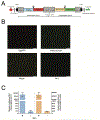A Conserved Basic Patch and Central Kink in the Nipah Virus Phosphoprotein Multimerization Domain Are Essential for Polymerase Function
- PMID: 30799076
- PMCID: PMC6690496
- DOI: 10.1016/j.str.2019.01.012
A Conserved Basic Patch and Central Kink in the Nipah Virus Phosphoprotein Multimerization Domain Are Essential for Polymerase Function
Abstract
Nipah virus is a highly lethal zoonotic pathogen found in Southeast Asia that has caused human encephalitis outbreaks with 40%-70% mortality. NiV encodes its own RNA-dependent RNA polymerase within the large protein, L. Efficient polymerase activity requires the phosphoprotein, P, which tethers L to its template, the viral nucleocapsid. P is a multifunctional protein with modular domains. The central P multimerization domain is composed of a long, tetrameric coiled coil. We investigated the importance of structural features found in this domain for polymerase function using a newly constructed NiV bicistronic minigenome assay. We identified a conserved basic patch and central kink in the coiled coil that are important for polymerase function, with R555 being absolutely essential. This basic patch and central kink are conserved in the related human pathogens measles and mumps viruses, suggesting that this mechanism may be conserved.
Keywords: Nipah virus; RNA-dependent RNA polymerase; X-ray crystallography; coiled coil; differential scanning calorimetry; henipavirus; minigenome; oligomerization; phosphoprotein.
Copyright © 2019 Elsevier Ltd. All rights reserved.
Conflict of interest statement
DECLARATION OF INTERESTS
The authors declare no competing interests.
Figures







References
-
- Blanc E, Roversi P, Vonrhein C, Flensburg C, Lea SM, and Bricogne G (2004). Refinement of severely incomplete structures with maximum likelihood in BUSTER-TNT. Acta crystallographica Section D, Biological crystallography 60, 2210–2221. - PubMed
Publication types
MeSH terms
Substances
Grants and funding
LinkOut - more resources
Full Text Sources

